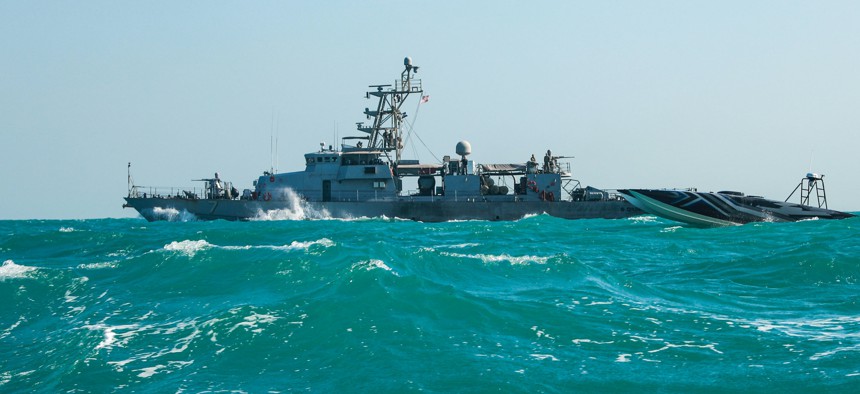
A MANTAS T-38 unmanned surface vessel operates alongside patrol coastal ship USS Squall (PC 7) in the Arabian Gulf, Dec. 4, 2021. U.S. Army / Sgt. David Resnick
Navy Chief Sees Robot Ships Alongside Aircraft Carriers Within Five Years
The service may create a new enlisted specialty to operate them.
SAN DIEGO—Aircraft carriers will deploy alongside large unmanned vessels within five years, if the Navy’s top officer gets his way.
In 2027 or 2028—”and earlier if I can”—Adm. Mike Gilday said he wants to begin to deploy large and medium-sized unmanned vessels as part of carrier strike groups and amphibious ready groups.
For the first deployments, such vessels “may not necessarily be completely unmanned; they may be minimally manned,” the chief of naval operations told reporters in a Wednesday conference call. “But I want to be in a position where we can crawl-walk-run” and “put us in a position where we can scale in the 2030s.”
One key to this, Gilday said, is doing as much testing and prototyping as possible at land-based facilities and simulators. At one testing facility in Philadelphia, “we can take an engineering configuration we want to use, and run that configuration for months and months,” he said. “We refine it. We replace the things that aren’t working well with a better component. And then we become a much better-informed customer in terms of what we want to buy and scale.”
The approach is being applied to more than unmanned systems, Gilday said. It draws on lessons from troubled recent surface-ship building programs such as the littoral combat ship, Zumwalt-class destroyer, and Ford-class aircraft carrier, and it is being used in the Constellation-class frigate and Columbia-class ballistic missile submarine programs. It is allowing Navy programs to “move in an evolutionary manner, instead of a revolutionary manner,” he said—and hopefully to avoid the kinds of problems that have plagued other recent efforts and drawn Congressional ire.
Another vital component, Gilday said, are the flexible and reliable wireless networks that will connect uncrewed vessels to the rest of a strike group. These seagoing networks—part of the larger networking effort dubbed Project Overmatch—will be able to shift automatically between various means of transmissions, just as your cellphone switches from your home wifi to the cellular network when you step outside. Each platform will look at the various kinds of data it needs to move, prioritize it into chunks, and send it off in the optimal order along the optimal mix of communications channels, he said.
Four carriers are currently being prepped to carry the new networking gear. Gilday said the first is “on track” to deploy late this year or early in the next. The next step will be putting the gear aboard several carrier groups and amphibious ready groups and conducting a large fleet exercise to test it out, he said.
Gilday said the Navy might ultimately create a new enlisted specialty to operate unmanned systems, and even build and modify applications to help.
“The chief of naval personnel is taking a look at a new unmanned rating,” he said. “Right now, we’re taking sailors out of their conventional ratings and they’re controlling unmanned vessels, and they’re getting really good at it. But it ought to be a rate in and of itself.”




